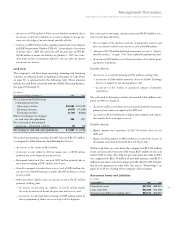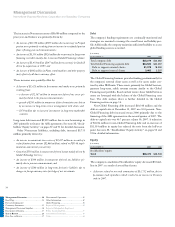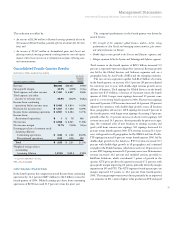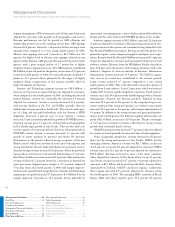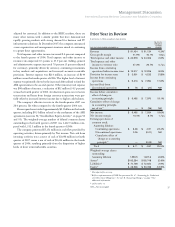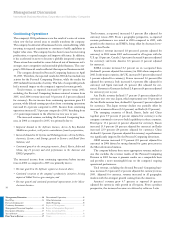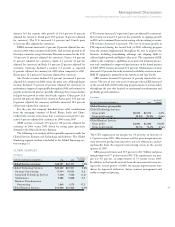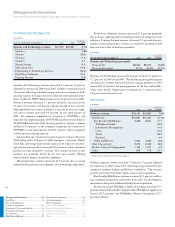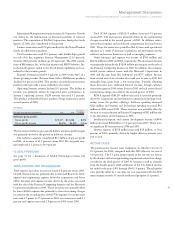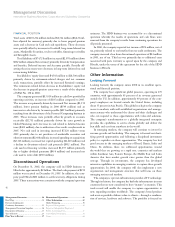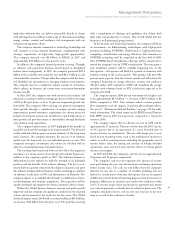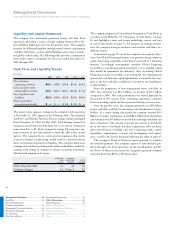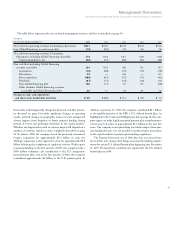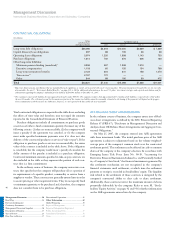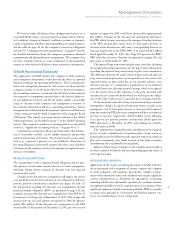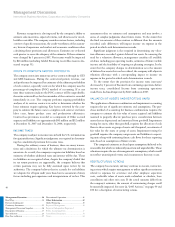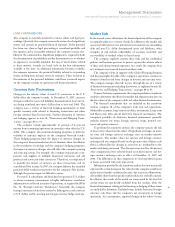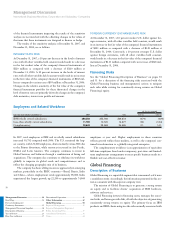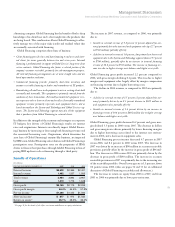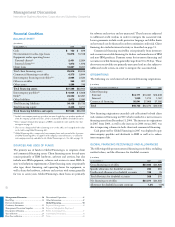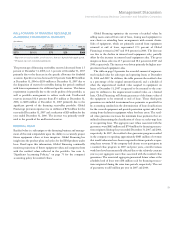IBM 2007 Annual Report Download - page 45
Download and view the complete annual report
Please find page 45 of the 2007 IBM annual report below. You can navigate through the pages in the report by either clicking on the pages listed below, or by using the keyword search tool below to find specific information within the annual report.Management Discussion
International Business Machines Corporation and Subsidiary Companies
43
high-value solutions that can deliver measurable benefit to clients
with offerings that can address a wide scope of client issues including:
energy savings, security and resiliency, risk management and cost
reduction among many others.
The company remains committed to technology leadership and
will continue to focus internal investments, complemented with
strategic acquisitions, on high-value, high-growth opportunities.
The company invested over $6 billion in RD&E in 2007 and
approximately $30 billion over the past five years.
In addition, the company’s financial position is strong. Through
its efficient cash generation business model based on disciplined
balance sheet management, in 2007, the company generated $12.4
billion in free cash flow and ended the year with $16.1 billion in cash
and marketable securities. This provides the company with the finan-
cial flexibility for investments in changing business environments.
The company also has a significant annuity content in its business
which reduces its business risk versus more transaction-dependent
business models.
In May 2007, the company met with investors and analysts and
discussed a road map to deliver earnings per share in 2010 in the range
of $10 to $11 per share, or 14 to 16 percent compound growth rate
from 2006. The company’s 2010 road map is to generate earnings per
share growth through a combination of revenue growth, margin
improvement, growth initiatives, acquisitions, the current projected
benefit of retirement-related cost and effective capital deployment to
fund growth and provide returns to shareholders through dividends
and common stock repurchases.
The company’s performance in 2007 highlighted the benefits of
its global reach and the strength of its business model. The financial
results reflected solid progress on major elements of the long-term
goals, however, the company measures the success of its business
model over the long term, not any individual quarter or year. The
company’s strategies, investments and actions are all taken with an
objective of optimizing long-term performance.
The continued investments in Software have led to this segment’s
emergence as a strong source of revenue growth and the largest con-
tributor to the company’s profit in 2007. The Software business is
differentiated in the industry by both the strength of its individual
products and the breadth of the software offerings. The key to con-
tinued Software growth stems from the ability to maintain and grow
this industry-leading software business, and by continuing to capitalize
on industry trends such as SOA and Information on Demand. The
company expects to accomplish this through a combination of inter-
nal development and strategic acquisitions. These products will be
rapidly developed and integrated to bring continued value to clients.
Within the Global Services business, revenue and profit growth
improved and the company saw significant results from the targeted
actions and investments it has made the last few years. The Global
Services business enters 2008 with a revenue backlog of $118 billion,
an increase of $2 billion from the prior year. The portfolio is strong
with a complement of offerings and capabilities that deliver both
high value and productivity to clients. The overall Global Services
business is well-positioned going forward.
In the Systems and Technology business, the company will focus
its investments on differentiating technologies with high-growth
potential including POWER6, BladeCenter-S, high-performance
computing, virtualization and energy efficiency. The transition to
POWER6 technology will be completed in the first half of 2008.
New POWER-based virtualization offerings will be announced to
extend the company’s lead in UNIX virtualization. The next genera-
tion mainframe product will be available beginning late in the
first quarter — that quarter will likely be a period of transition with
benefits coming in the second quarter. This product will have fifty
percent more capacity than the current system and will extend the
company’s leadership in energy efficiency, security and resiliency.
The December, 2007 acquisition of XIV will strengthen the storage
portfolio with solutions based on XIV architecture expected to be
announced in 2008.
The company expects 2008 pre-tax retirement-related plan cost
to be approximately $1.6 billion — a decrease of $950 million to $1
billion compared to 2007. This estimate reflects current pension
plan assumptions and the impacts of pension plan redesign efforts.
See note U, “Retirement-Related Benefits,” on page 106 for addi-
tional information. The actual return on the IBM Personal Pension
Plan (PPP) assets in 2007 was 14 percent, compared to a 15 percent
return in 2006.
The company expects that its effective tax rate in 2008 will be
approximately 27.5 percent. This rate is lower than the 2007 tax rate
of 28.1 percent due to an expectation of a more favorable mix of
income in lower tax jurisdictions. The rate will change year to year
based on non-recurring events, such as the settlement of income tax
audits, as well as recurring factors including the geographic mix of
income before taxes, the timing and amount of foreign dividend
repatriation, state and local taxes and the effects of various global
income tax strategies.
In 2007 and 2006, the company’s cash tax rate was approximately
18 percent and 16 percent, respectively.
The company’s cash tax rate represents the amount of income
taxes paid during the year over Income from continuing operations
before income taxes. The cash tax rate differs from the company’s
effective tax rate due to a number of variables including, but not
limited to, certain items of income and expense that are recognized
in different years for financial reporting purposes than for income tax
purposes, differences in currency rates used in the translation of the
non-U.S. income tax provision and income tax payments and current
year cash tax payments or refunds that are related to prior years. The
company anticipates that its cash tax rate may increase in the near
term as a result of the settlement of audits.


